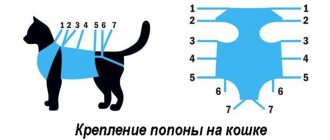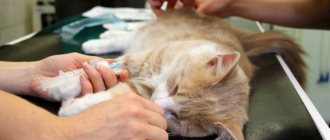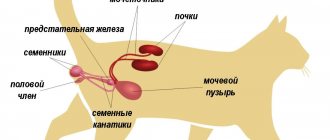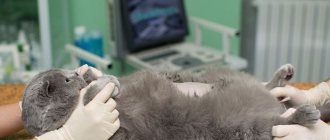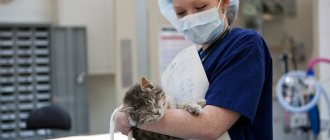Early castration of cats has a lot of conflicting information about the consequences of the operation. Some forums recommend castration no earlier than 6 months, while others say that surgery can be performed earlier. Let's try to understand the heated debate and find out the truth.
Making the decision to castrate
The question of the need for castration must begin to arise in every kitten owner almost from the first days of his appearance in the house. Often, lack of awareness gives rise to painful doubts in this regard. After all, the decision to carry out the actual operation falls squarely on the shoulders of the owners. And just as it is not easy for a parent to take responsibility for the fate of a child, it is far from easy to decide on such an important act in the life of the pet you care for. In this article we will take a detailed look at all aspects of this operation in order to help you make the right choice.
Why do you need to castrate cats?
When choosing between who to take into the house - a “boy” or a “girl”, many prefer male kittens. But by six months the cute kitten begins to show sexual activity. The result affects the furniture, carpets, and shoes of the owners. A cat living at home instinctively leaves odorous marks that cannot be eliminated.
Often, a cat’s natural instincts lead to tragedy. An animal can jump out of a window or from a balcony, or slip out of a slightly open door. If a cat has never been outside, he will not be able to withstand a fight with tailed street fighters. And the cat is unlikely to find his way home. Another "lost" one. Even if the cat was found and returned home, it is not a fact that he did not manage to become infected with the infection from street animals.
The other “side of the coin”: castration will help reduce the population of animals born on the streets. If a cat is free-range, he will definitely find a “girlfriend”. Weak and non-viable kittens are doomed to death or even more sickly offspring.
Castration of a cat changes not only its sexual habits, but also its character. The animal stops marking its territory and calmly treats the females living in the house. Owners note the gentler and calmer disposition of a neutered cat - he does not show aggression towards people or “rivals”.
The difference between castration and sterilization. Terminology
First, let's define the terms. Contrary to the popular belief that castration is performed on males and sterilization on females, these are concepts common to both sexes. There are different methods of castration and sterilization.
Castration refers to the removal of reproductive organs from both male and female cats. In cats, the testes (testes) are removed; in cats, the uterus and ovaries are removed. After castration, animals cannot have offspring, libido and associated behavioral characteristics disappear.
Sterilization of cats and female cats is the termination of reproductive ability without removing the organs themselves. This effect can be achieved by performing surgical operations similar to castration or using special drugs (so-called “chemical” sterilization). The behavior of a cat after sterilization will be similar to the behavior after castration, as well as caring for a cat after sterilization.
In the vast majority of cases, animals undergo castration. Complete removal of the genital organs in kittens at an early age allows you to once and for all solve the problem of unwanted sexual behavior, reduce the pet’s aggression towards other animals and people, and prevent many hormonal diseases: tumors of the mammary glands and ovaries, inflammatory diseases of the uterus and prostate.
Contact us
Routine castration of cats is performed surgically. Although spaying is traditionally done around 6 months of age, it can be done earlier, between 2 and 4 months. FVE in this document defines early castration before (!) 4 months of age. In some countries, early castration is widespread, while in others the practice is not common. This document provides an overview of the advantages and disadvantages of early castration.
FVE position:
· No kitten should be neutered before weaning (about 8 weeks).
· There cannot be a specific recommendation on when to perform castration, earlier (between 2 and 4 months) or later (after 4 months), since both methods have pros and cons. The decision must be made on the basis of the risks and benefits for each individual animal, taking into account current information, and the decision must include a veterinary aspect regarding anesthesia and analgesia.
· To prevent unwanted matings and control the population, if all conditions are met, early castration may be recommended.
· For individual cat maintenance, FVE recommends castration after 4 months. Careful review of scientific information is necessary before recommending early neutering for individually housed cats.
Basics:
Surgical castration by bilateral removal of the gonads is a routine technique that allows reliable control of feline reproduction. Although this is a routine operation, it is necessary to weigh (as with any operation) the benefits and risks to the animal, current and long-term. Currently, in some countries/regions, the indications and, in particular, the consequences of early castration remain a controversial issue. In this document we focus on kitten neutering and build on the current state of knowledge on early neutering from an animal welfare perspective.
Definitions:
· Early castration: this definition varies in different countries and publications: from 6 to 12 weeks, between 6 and 16 weeks or up to 6 months. In the literary sense, the word “early castration” means “before the onset of puberty.” Since maturation in some cats occurs at the age of 4 months (the ability to produce offspring, changes in the smell of male urine), we suggest early castration before 4 months.
· Lactating kittens (under 8 weeks of age) do not eat enough food to recover best from surgery, making surgery before this age undesirable. In this document we consider early castration between 2 and 4 months.
· Castration: bilateral surgical removal of the gonads, usually used to remove the testes in cats.
· Neutering: This word is usually used for females when referring to the removal of the ovaries and uterus. However, the correct name for this operation is ovariohysterectomy (OHE).
· Gonadectomy: surgical removal of the gonads (testes or ovaries).
· Ovariectomy: surgical removal of the ovaries.
· OGE: surgical removal of the ovaries and uterus.
Statement of current practice:
In some countries (UK, Belgium, USA, Australia, etc.) early castration is widely used, while in other countries it is not a common practice.
The situation varies greatly from country to country due to the state of veterinary medicine, including the availability of equipment and supplies (for administering anesthesia), the level of veterinary education and the availability of information on growth, behavioral changes and the risk of obesity in kittens castrated at an early age. Research conducted in the US and UK shows that those who support early castration are those with experience, and vice versa. Review of the advantages and disadvantages of early castration between 2 and 4 months of life:
Current risks: Anesthesia and surgery. The characteristics of very young animals (size, susceptibility to hypoglycemia and hypothermia, etc.) cause increased anesthetic and surgical risks. With careful attention to the physiological and behavioral characteristics of young patients, as well as taking into account good operating conditions (maintenance of heat, availability of anesthesia, fasting for no more than 3 hours, etc.), early castration poses no greater risk than at a later age . The authors note that the operation itself is simpler, faster, less traumatic for the animal, and more profitable. Pre- and postoperative complications are noted to be the same or less significant with early castration compared to late. From an anesthetic and surgical perspective, the harm-benefit analysis between early and late castration largely depends on the conditions of safe practice in the context of very young cats.
Effects and long-term potential risks:
- Tumors of the mammary glands. Studies indicate that the risk of developing mammary tumors is significantly reduced in cats that are neutered before 6 months of age. The additional benefits of castration performed before 4 months to reduce the risk of AML remain to be clarified.
- Height. A number of authors have studied the growth of the radius and ulna in male cats depending on the age of castration (from 7 weeks to 7 months). Delayed closure of the proximal growth plate was noted in early neutered females, indicating slower growth in early neutered kittens. The clinical significance of slower growth remains uncertain. Studies also do not show an increased risk of fractures. It is possible that the risk of injury is lower due to the lack of tendency of neutered cats to roam. With regard to growth, more in-depth and retrospective studies are needed to analyze the harm-benefit of reduced growth and increased final bone length in relation to the health and welfare of cats.
- Obesity. Regardless of the age of castration, this may be associated with increased food intake and weight gain, so feeding restrictions are required. Several studies focusing on the relationship between age at neutering and obesity in cats show that neutering at 7 weeks of age reduces the risk of weight gain compared to 7 months. One study noted that plasma leptin concentrations in cats 6–8 months of age were higher in early neutered cats (8–12 weeks of age) compared to late neutered cats (6–8 months of age). In relation to weight, a harm-benefit analysis suggests that early castration is preferable.
- Diseases of the urinary system. Castration results in significant regression of penile spicules in cats, but at an early age castration results in a lack of development. There is no information about the consequences of this. There is no strong scientific evidence yet that the age of neutering influences the occurrence of urinary disorders, but some studies have implicated neutering as a predisposing factor for the development of urinary tract obstruction. With regard to diseases of the urinary system, the harm-benefit analysis is identical for early and late castration.
- Infectious diseases. The risk of infectious diseases does not increase if castration is performed earlier than 5.5 months. To our knowledge, there are no studies on the effect of early castration on the risk of infectious diseases. Conversely, in feral colonies of cats that are not neutered before puberty, due to the increased number of contacts, more kittens are susceptible to infectious diseases. In relation to infectious diseases, the harm-benefit ratio between early/late castration requires further study.
- Other diseases. Few studies have specifically addressed the relationship between early castration and the risks of musculoskeletal disorders. Some authors describe an increased risk of fractures in neutered males with delayed cartilage growth, while others have noted no significant difference between cats neutered between 8-12 weeks and cats neutered between 6-8 months in terms of lameness and fractures, and hypersensitivity reactions. Cats neutered before 5.5 months have a lower incidence of gingivitis. According to one study, neutering may be a predisposing factor for the development of epiphysiolysis in Maine Coons, although a hereditary predisposition for this disease is most likely. From the point of view of fractures, lameness, and skin diseases, the harm-benefit ratio between early/late castration requires further study.
- Behavior. Most studies have examined the effect of early castration on behavioral aspects such as uncleanliness, aggression towards members of the species or people, and damage to objects. Unfortunately, these studies did not consider the relationship of specific age of early castration to aspects of behavior.
- Uncleanliness. A number of authors describe identical levels of urine marking and urination in the wrong place in early and late neutered cats and female cats. However, a recent study shows a significant reduction in the frequency of urination in inappropriate places during the first month after moving to a new home in early spayed females compared to later spayed females. Among cats (neutered before 5.5 months), the frequency of marks was lower compared to cats that were neutered at an older age.
- Aggression within a species. Among cats neutered before 5.5 months of age, the incidence of abscesses (associated with intraspecies aggression) was lower compared to later neutered cats. One study (comparing cats neutered between 6 and 13 weeks and 5-7 months) shows a decrease in intraspecific conflict and aggression during the first month after relocation, but then this effect disappears.
- Aggression towards people. According to a study (comparing cats neutered between 6 and 13 weeks and 5-7 months), the incidence of aggression towards people was significantly reduced in adulthood in cats neutered early compared to those neutered later.
- Shyness. Among cats that underwent early castration (before 5.5 months), the incidence of the desire to hide (among males) and shyness (among males and females) was higher.
From a behavioral perspective, we can only conclude that early neutering reduces unwanted behavior in kittens from shelters and nurseries. More research is needed to analyze the harm-benefit relationship between early/late castration in relation to behavioral factors.
Welfare of cats neutered at an early age:
At the cat population level:
· Early castration has undeniable advantages. When carried out before the kitten is picked up, it prevents further reproduction and improves population control. Leads to a lower incidence of disease in outdoor cats. A kitten that is adopted neutered is more likely not to be abandoned. Early castration carried out simultaneously with identification improves control over the street population.
· Early castration has the same limiting effect as late castration on genetic diversity. However, since mostly non-pedigreed cats are castrated, this could potentially lead to a decrease in the number of non-pedigreed cats and encourage owners to buy purebred cats.
· Hereditary diseases tend to be more common among purebred cats because selection and inbreeding to promote certain breed traits can also increase the risk of hereditary diseases.
At the individual level:
· Early neutering has several benefits: it reduces unwanted behavior such as urine marking, urinating in the wrong place and aggression. This helps improve the quality of the cat’s relationship with its owner, and hence the cat’s well-being. Early castration can, on the other hand, also cause an increase in fearfulness.
· For other parameters (weight, lameness, skin diseases, infectious diseases), most studies show no disadvantage of early neutering compared to late neutering and therefore no impact on the cat's welfare.
· Research is still ongoing into the effects of early castration on the individual. The development of kittens adopted from families or breeders has not been taken into account in previous studies because most studies evaluate the effects of early neutering in shelter cats. Additionally, many areas have not yet been researched, such as the effect of early neutering on behavior other than undesirable ones. For example, nothing is known about the effects on cognitive skills or social abilities, which may affect animal welfare. In dogs, gonadectomy influences the progression of cognitive impairment in aging dogs. There have been no studies on whether early castration has more important effects or not. In rats, early gonadectomy reduces sexually dimorphic behavior, juvenile rough play, and levels of synaptic transmission in adulthood.
REFERENCES
Alexander LG, Salt C., Thomas G., Butterwick R., 2011. Effects of neutering on food intake, body weight and body composition in growing female kittens. British journal of Nutrition, 106(Suppl 1), S19-S23. Beauvais W.,
Cardwell JM, Brodbelt DC, 2012. The effect of neutering on the risk of mammary tumors in dogs—a systematic review. J Small Anim Pract, 53(6):314-22
Borak D., Wunderlin N., Brückner M., Schwarz G., Klang A. 2021. Slipped capital femoral epiphysis in 17 Maine Coon cats. J Feline Med Surg. 2021 Jan;19(1):13-20. doi: 10.1177/1098612X15598551. Epub 2016 Jul 10
Borges NC, Pereira-Sampaio MA, Pereira VA, Abidu-Figueiredo M., Chagas MA, 2017/ Effects of castration on penile extracellular matrix morphology in domestic cats J Feline Med Surg. 2021 Dec;19(12):1261-1266. doi: 10.1177/1098612X16689405. Epub 2021 Feb 8..
Cooke BM, Woolley CS, 2009. Effects of prepubertal gonadectomy on a male-typical behavior and excitatory synaptic transmission in the amygdala. Dev Neurobiol February 1; 69(2-3): 141–152
Gagnon et al, 2021. Round table on early neutering in cats. 18-19 Oct 2021.
Gourley J., 1987. When to spay. Vet Rec, 121(16), 384.
Houlton JE, McGlennon NJ, 1992. Castration and physeal closure in the cat. Vet rec, 131(20), 466-467.
Howe LM, Slater MR, Boothe HW, Hobson HP, Fossum TW, Spann AC, Wilkie WS, 2000. Long-term outcome of gonadectomy performed at an early age or traditional age in cats. J Am Vet Med Assoc 217(11):1661–5.
Lieberman L.L., 1988. Optimum time for neutering. Ver Rec, 122(24), 591.
Lieberman LL, 1988. The optimal time for neutering surgery of dogs and cats. Vet Rec, 122(15), 369.
Looney AL, Bohling MW, Bushy PA, Howe LM Griffin B, Levy JK et al, 2008. The association of shelters veterinarians medical care guidelines for spay-neuter programs. J. Am. Vet. Med. Assoc., 233(1), 74-86.
Murray JK, Skillings E., Gruffydd-Jones TJ, 2008. Opinions of veterinarians about the age at which kittens should be neutered. Vet Rec, September 27, 2008
Olson, P.N., 1997. Early spay and neuter. In: Proceedings of the north American veterinary conference, Orlando, Florida, January 11-15 1997, 657-658.
Overley B., Shofer FS, Goldschmidt MH, Sherer D., Sorenmo KU, 2005. Association between ovariohysterectomy and feline mammary carcinoma. J Vet Intern Med. July-Aug; 19(4):560-3. 8 | Page
Patronek GJ, Glickman LT, Beck AM, McCabe GP, Ecker C., 1996. Risk factors for the release of cats to an animal shelter. J Am Vet Med Assoc. 1996 Aug 1;209(3):582-8.
Perry KL, Fordham A., Arthurs GI, 2014. Effect of neutering and breeding on femoral and tibial physeal closure times in male and female domestic cats. Journal of Feline Medicine and Surgery 16, 149–156.
Porters N., Polis I., Moons C., Duchateau L., Goethals K., Huyghe S., de Rooster H., 2014. Prepubertal gonadectomy in cats: different surgical techniques and comparison with gonadectomy at traditional age. Vet Rec 175(9):223.
Porters N., Polis I., Moons CPH., Van de Maele I., Ducatelle R., Goethals K., Duchateau L., de Rooster H., 2015. Relationship between age at gonadectomy and health problems in kittens adopted from shelters . Vet Rec176, 572.
Root MV, Johnston SD, Olson PN, 1996. Effect of prepubertal and postpuberal gonadectomy on heat production measured by indirect calorimetry in male and female domestic cats. American Journal of Veterinary Research 57, 371–374.
Root MV, Johnson SD, Olson PN, 1997. The effect of prebubertal and postpubertal gonadectomy on radial physeal closure in male and female domestic cats. Vet Radiol Ultrasound, 38(1), 42-47.
Root Kustritz, M. V., 1999. Early spay-neuter in the dog and cat. Veterinary Clinics of North America: Small Animal Practice 29, 935–943.
Root Kustritz, M.V., 2013. Pros, cons, and techniques of pediatric neutering. Veterinary Clinics of North America: Small Animal Practice 44, 221–233.
Scandurra A., Marinelli L., LÖoke M., D'Aniello B., P., 2021. The effect of age, sex and gonadectomy on dogs' use of spatial navigation strategies. App Anim Behav Sc, 205, 89-97.
Spain CV, Scarlett JM, Cully, SM, 2002. When to neuter dogs and cats: a survey of New York state veterinarian's practices and beliefs. J am Anim Hosp Assoc, 38(5), 482-488.
Spain CV, Scarlett JM, Houpt KA, 2004. Long-term risks and benefits of early-age gonadectomy in cats. J Am Vet Med Assoc 224(3):372–9.
Stubbs WP, Bloomberg MS, Scruggs SL, Shille VM, Lane TJ, 1996. Effects of preburbertal gonadectomy on physical and behavioral developments in cats. J Am Vet Med Assoc, 209(11), 1864-71.
Wei A., Fascetti A. J., Kim K., Lee A., Graham J. L., Havel P. J., & Ramsey J. J. (2014). Early effects of neutering on energy expenditure in adult male cats. PloS one, 9(2), e89557. doi:10.1371/journal.pone.0089557
Wright JC, Amoss RT, 2004. Prevalence of house soiling and aggression in kittens during the first year after adoption from a humane society. J Am Vet Med Assoc 224(11):1790–5.
What to talk to your veterinarian about?
- What can you do to minimize stress? What should be the preparation for the procedure?
- How will your pet feel after anesthesia? How long will my pet need to be closely monitored and cared for after surgery?
- What will the cat's suture look like after surgery and what will be the care involved?
- Is it necessary to wear a post-operative cat blanket or protective collar for cats?
- How long does it take to fully recover after surgery?
- When should I go for an examination after surgery to assess the cat’s condition?
Postoperative period
Usually the animal quickly recovers from anesthesia, and the postoperative period passes without complications. During the first 24 hours, you should look after your pet and limit its mobility. The first hours after waking up the cat will stagger. After 3-4 hours you can give him water. Do not allow the operation site to be licked; monitor the hygiene of the tray. It is better not to use the filler for a few days.
After the operation, the wound will cause discomfort to your pet for several days. It may itch, then the cat will try to lick it. It is recommended to treat the wound with an antiseptic and put a protective collar on the cat.
You can feed the cat only the next day after surgery. The diet will have to be reconsidered - castrated cats are at risk of developing urolithiasis and kidney problems.
Some owners ask the veterinarian why the cat loses weight after castration . Short-term weight loss is the norm; after suffering stress, the body needs some time to recover. With the right food and proper nutrition management, appetite will return and metabolism will normalize.
If after a few weeks the weight has not returned to normal, you should contact a veterinarian. Reasons for losing weight may be:
- the presence of worms;
- disruption of internal organs.
Preferred castration method
When castrating a cat, the surgeon makes one or two small incisions in the skin on the scrotum. Through these incisions, the testicles are removed and subsequently removed. This procedure is relatively simple and does not require prolonged anesthesia for the cat. There is no significant variety in the technique of performing this procedure.
In the case of castration of a cat, not only an incision is made in the skin, but also in the abdominal wall (abdominal muscles). This allows access to the abdominal cavity to extract and remove the ovaries and uterus. At the end of the operation, stitches are placed on the wound. Depending on the technical equipment of the clinic, you will be offered a standard or laparoscopic operation. The difference with laparoscopy is that the entire procedure is performed under the supervision of a small camera placed in the abdomen through an incision. This increases the safety of castration and most often (depending on the experience of the surgeon) reduces its traumatic nature.
Regardless of which method of cat castration you choose, remember that carrying out such operations in a veterinary clinic is standard practice, castration techniques are well known and proven, and the risks of complications after the procedure are very small. Give preference to trusted veterinary clinics and surgeons with extensive experience.
Anesthesia for castration of a cat
To choose the optimal method of pain relief, the veterinarian will examine the cat and take measurements of vital signs:
- temperature;
- heart rate;
- blood pressure.
The veterinarian will perform surgery only if he receives confirmation that the cat is healthy enough to recover from anesthesia.
Most often, the animal is sedated using an injection. An intravenous catheter is inserted through the shaved area of the paw.
Inhalation anesthesia
Most cats are given anesthetics by injection or intravenous catheter. After falling into a light sleep, the anesthesiologist will insert an endotracheal tube through which anesthetic gas will be administered.
The animal will also be connected to equipment that monitors heart rate, breathing, and blood pressure. Most veterinary clinics use an inhaled drug - isoflurane or sevoflurane.
Non-inhalational anesthesia
The most common type of sedation and analgesia is a combination of drugs. The operation to remove the testes is quite simple and takes approximately 10-15 minutes.
Most often, this manipulation uses a combination of a sedative intravenous drug and a local anesthetic, which is injected directly into the testes themselves for pain relief.
Let's consider the pros and cons of castration
Pros:
- Prevention of unwanted pregnancy.
- Elimination of unwanted sexual behavior: aggression, anxiety, cats stop marking.
- Timely sterilization helps to increase the life expectancy of your pet.
- It is possible to prevent the development of diseases of the reproductive system and hormonal-related pathologies.
- The risk of your pet getting lost or contracting an infectious disease if it escapes is significantly reduced.
Minuses:
- Psychological stress for the animal.
- Risks of complications (surgical, anesthetic).
- Risks of obesity and diabetes associated with decreased activity and increased appetite in cats.
- The risks of developing certain cat diseases (urolithiasis, cystitis) increase.
- Rehabilitation requires your attention.
- The procedure is irreversible. If the owner “changes his mind”, it will be impossible to restore the ability to give birth to kittens.
General facts
Castration is considered not such a simple operation as many assume. This is not just the removal of the testes: during the operation, the glands of the genital organs are cut and the reproductive functions of the body are completely stopped. The procedure can be carried out using several methods:
- Standard excision. This technique is the most common and simple.
- Fertility with the help of medications. For this, an implant is sewn under the skin with the required amount of medication that suppresses the cat’s sexual desire. This is an expensive but safe procedure.
- Chemical sterilization, during which a mixture of drugs is injected directly into the testes. This compound destroys the glands. Their tissue is then replaced by muscle tissue. This procedure, which has not taken root in our country, is considered easy to use and cheap.
- Castration under the influence of radiation. The organ is placed under gamma rays and treated. Such manipulation requires quite expensive equipment. From a safety point of view, this is a simple intervention that does not require anesthesia.
It is clear that surgical penetration into the animal's body is not always necessary. However, it is excision with a scalpel that is popular in domestic veterinary practice. Most likely, this is due to the low cost of the method.
Minimizing possible negative consequences of surgery
The main negative consequences of castration boil down to the likelihood of developing obesity, diabetes and urolithiasis. The best way to prevent these problems at the moment is considered to be the correction of the pet’s diet, which consists of reducing calories and optimizing the mineral composition. This can be done by selecting special food after sterilization (castration). Of course, if we are talking about a kitten, the diet after surgery should include a large amount of easily digestible protein, and should also be enriched with vitamins and fatty acids in the quantities necessary for the growing body. PRO PLAN® Sterilized food for sterilized kittens meets all the requirements listed above. Its balanced composition will ensure the prevention of undesirable consequences of castration and will promote the healthy growth and development of the kitten.
Preparing a cat for castration
The most important rule for the owner: remain calm throughout the entire period of preparation for the operation. Pets understand human emotions very well. The pet will feel anxious and begin to hide and behave aggressively. It is necessary to maintain a fasting diet for 6-8 hours before anesthesia. Water can and even should be left available.
If castration will be carried out by a veterinarian who has not previously examined the cat, it is necessary to prepare information about vaccinations, medications and diseases that the animal has suffered. The owner will also be asked to sign a consent form for the use of anesthesia, an information sheet regarding possible complications after the operation.
From 2-5 years
It happens that a cat ends up with its owners as an adult. If there are no contraindications, cats can be neutered at this age. You shouldn't expect much effect from the manipulation. The cat's body developed under the influence of sex hormones.
Castration of an adult pet will not solve problems with marking the premises with urine, attempts to escape from the house and regular howling. Unfortunately, it is almost impossible to correct the habits and behavior of an older cat.
The disadvantages outweigh the benefits of the intervention
- Risk of physical inactivity.
- Gaining excess weight. Corrected by a specially selected diet
The operation is performed only under general anesthesia.
